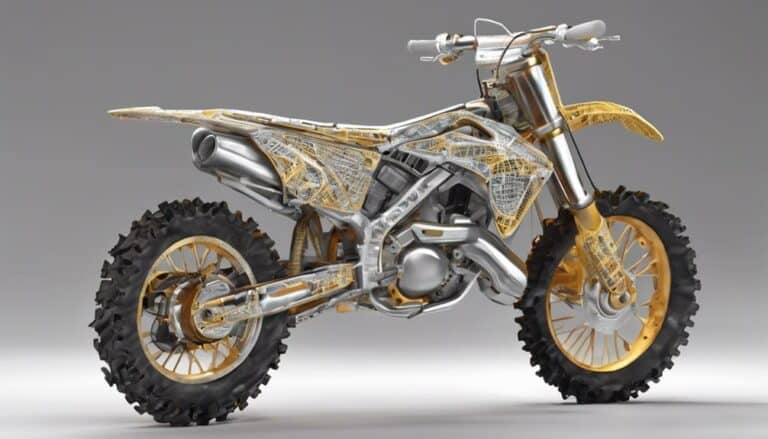When it comes to the debate between two-stroke and four-stroke engines in motocross dirt bikes, the differences go beyond just the number of strokes.
While one may boast raw power like a thunderous storm, the other offers a refined precision akin to a skilled orchestra conductor.
Understanding how these engines compare regarding operation, weight, maintenance, fuel efficiency, and environmental impact is important for making an informed choice that aligns with your riding style and preferences.
Explore the intricacies of these engine types to uncover which one could be your ultimate ride companion on the dirt track.
Key Takeaways
- Two-strokes offer immediate power, ideal for quick acceleration in motocross.
- Four-strokes provide smoother power delivery and torque for a more predictable ride.
- Two-strokes are lighter, enhancing agility in technical terrain.
- Four-strokes are more stable and have lower maintenance costs for long-term use.
Engine Operation and Performance Differences
Comparing the engine operation and performance differences between two-stroke and four-stroke engines in motocross dirt bikes reveals important distinctions in power delivery and overall performance on the track.
Two-stroke engines, with their simpler design lacking camshafts and valves, provide immediate power output as they fire each time the piston reaches the top. This characteristic results in a unique power curve known for its responsiveness, ideal for quick acceleration out of turns.
In contrast, four-stroke engines, with separate strokes for intake and exhaust, offer smoother power delivery and torque, making them suitable for controlled acceleration and maneuvering technical sections with precision.
The piston movement in a two-stroke engine completes a power cycle in one revolution, while four-stroke engines necessitate two revolutions for the same process. This distinction affects not only power delivery but also the maintenance requirements of these engines.
Two-strokes, with fewer parts involved in the combustion process, generally require less maintenance compared to the more complex four-stroke engines.
Weight and Handling Variances
The weight and handling variances between two-stroke and four-stroke dirt bikes greatly influence rider performance and track dynamics, impacting maneuverability and stability in diverse racing conditions.
Two-stroke dirt bikes, known for their lightweight nature, excel in agility and quick operations on the track. The reduced weight of two-stroke engines enhances responsiveness, making them ideal for operating technical terrain with ease.
On the other hand, four-stroke dirt bikes, being heavier than their two-stroke counterparts, offer increased stability and traction on various track surfaces. The added weight of four-stroke engines provides riders with a more planted feel, especially in challenging conditions. However, this weight can pose challenges in tight corners, requiring more effort to operate compared to the nimble two-strokes.
When choosing between two-stroke and four-stroke dirt bikes, riders often consider factors such as weight, handling characteristics, and the specific track surfaces they'll be riding on to optimize their performance.
Maintenance Requirements and Costs
When evaluating maintenance requirements and costs for two-stroke and four-stroke dirt bikes, it's essential to take into account the simplicity of design and the frequency of upkeep tasks. Two-stroke engines generally have lower maintenance costs due to their uncomplicated construction and fewer components compared to four-stroke engines. The maintenance intervals for two-stroke engines are shorter, necessitating more regular attention, including tasks like top-end rebuilds. These maintenance tasks on two-stroke engines are typically simpler and quicker to perform than the more intricate procedures needed for four-stroke engines.
In relation to maintenance costs, two-stroke dirt bikes prove to be more cost-effective and easier to maintain than their four-stroke counterparts. Four-stroke dirt bikes generally require more frequent servicing and have higher expenses associated with engine rebuilds. Considering the overall maintenance requirements and costs, opting for a two-stroke engine may be a more economical choice for riders looking to minimize upkeep expenses while ensuring the bike remains at its best condition.
Fuel Efficiency and Power Delivery Variances
In evaluating fuel efficiency and power delivery variances between two-stroke and four-stroke engines in motocross dirt bikes, the distinction lies in their distinct performance characteristics. The compression stroke, intake and exhaust functions, and power band play significant roles in shaping these differences:
- Two-stroke Engines:
- Provide instant acceleration due to their unique power delivery mechanism.
- Offer a narrower power band but deliver high power and torque in a specific range.
- Have fewer moving parts, making them lighter and easier to handle for riders with an aggressive riding style.
- Four-stroke Engines:
- Deliver consistent power throughout the rev range, making them easier to control on various terrains.
- Provide smoother power delivery, suitable for riders who prefer a more predictable riding experience.
- Produce lower exhaust emissions and have a cleaner combustion stroke, aligning with environmental considerations.
Environmental Impact and Regulatory Considerations
Considering the environmental impact and regulatory considerations surrounding motocross dirt bikes, the focus shifts towards understanding the emissions implications of different engine types.
Two-stroke engines, commonly found in motocross bikes, emit higher vehicle exhaust emissions compared to four-stroke engines. This higher emission rate contributes to environmental concerns, as pollutants like burnt oil fumes are released into the atmosphere.
The Environmental Protection Agency (EPA) has introduced stricter regulations to reduce pollution from engines, affecting two-stroke dirt bikes. While modern two-stroke engines have been developed to meet EPA standards, they still have an environmental impact due to their emissions.
Emissions from two-stroke engines not only lead to higher fuel consumption but also contribute to pollution, emphasizing the importance of raising awareness about the environmental impact of these engines in the motocross community. Understanding the environmental implications and complying with regulations are essential steps towards reducing emissions and protecting the environment in motocross racing.
Conclusion
So, after all that analysis, you've finally come to a decision on whether to go with a two-stroke or four-stroke engine for your motocross dirt bike. Congratulations!
Just remember, at the end of the day, it's not about the power, weight, or maintenance costs – it's about the sheer thrill of ripping through those dirt tracks and feeling the adrenaline rush.
So go ahead, make your choice, and enjoy the ride!

